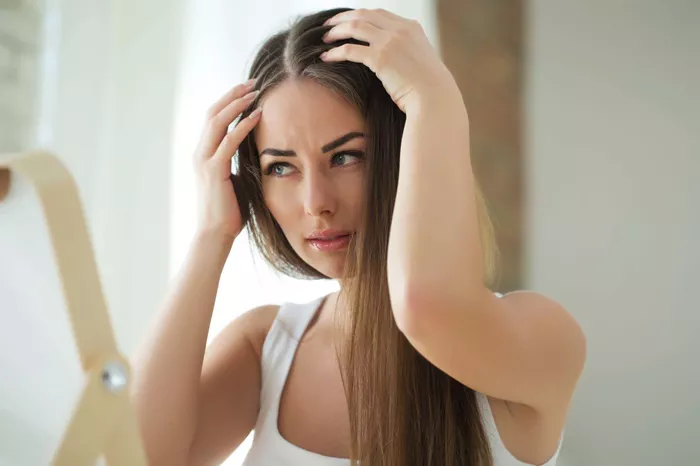Hair loss, particularly a receding hairline, is a concern that affects many women. Unlike men, whose hair loss is often linked to androgenetic alopecia (male pattern baldness), women experience hair thinning in different ways. A receding hairline in women can be distressing and confusing, as it doesn’t always follow the same patterns as it does in men. This article explores the various causes of a receding hairline in women, using simple language and clear explanations to help you understand this complex issue.
1. Hormonal Changes
Hormonal imbalances are one of the primary reasons for a receding hairline in women. Hormones play a crucial role in regulating hair growth, and any disruption can impact the hair follicles. The most common hormonal changes that affect women include:
Pregnancy:
During pregnancy, women experience significant hormonal fluctuations. After childbirth, the drop in hormones can lead to a condition known as postpartum hair loss, which may contribute to a receding hairline.
Menopause:
As women approach menopause, estrogen levels decrease. Estrogen is vital for hair health, and lower levels can lead to thinning hair and a receding hairline.
Polycystic Ovary Syndrome (PCOS):
This condition causes an imbalance in sex hormones, leading to symptoms such as excessive hair growth on the face and thinning hair on the scalp.
2. Genetics
Genetics play a significant role in hair loss. If female relatives in your family have experienced hair thinning or a receding hairline, there is a higher likelihood that you may also face similar issues. Genetic predisposition means that your hair follicles are more susceptible to shrinking over time, which leads to a receding hairline.
3. Stress
Chronic stress is a significant factor that can lead to a receding hairline in women. Stress triggers the release of cortisol, a hormone that can impact hair growth. High levels of cortisol can disrupt the normal hair growth cycle, causing hair to enter the shedding phase prematurely. This type of hair loss is often temporary but can still result in noticeable thinning and a receding hairline.
4. Nutritional Deficiencies
A poor diet lacking essential nutrients can lead to hair loss. Hair needs a variety of vitamins and minerals to grow and remain healthy. Deficiencies in the following nutrients can contribute to a receding hairline:
Iron:
An iron deficiency can lead to hair thinning and loss.
Vitamin D:
Low levels of vitamin D are linked to hair loss conditions such as alopecia.
B Vitamins:
B vitamins, especially biotin, are essential for hair health.
Zinc:
A deficiency in zinc can impair hair growth and lead to thinning.
SEE ALSO: Which Fish is Good for Hair Growth?
5. Medical Conditions
Certain medical conditions can cause hair loss, including a receding hairline:
Thyroid Disorders:
Both hypothyroidism (underactive thyroid) and hyperthyroidism (overactive thyroid) can lead to hair thinning and a receding hairline.
Autoimmune Diseases:
Conditions such as alopecia areata, where the immune system attacks hair follicles, can cause sudden hair loss and receding hairlines.
Scalp Conditions:
Fungal infections or psoriasis affecting the scalp can lead to hair thinning and a receding hairline.
6. Medications
Some medications have side effects that include hair loss. Common culprits include:
Antidepressants:
Certain antidepressants can lead to hair thinning.
Blood Pressure Medications:
Medications used to manage high blood pressure can sometimes result in hair loss.
Hormonal Treatments:
Medications for hormonal therapy or birth control can impact hair growth.
7. Hair Treatments and Styling
Aggressive hair treatments and styling practices can damage hair follicles and contribute to a receding hairline. These include:
Chemical Treatments:
Frequent use of hair dyes, perms, and relaxers can weaken hair and lead to thinning.
Heat Styling:
Regular use of heat tools such as straighteners and curling irons can damage the hair shaft and follicles.
Tight Hairstyles:
Styles that pull on the hair, such as tight ponytails or braids, can cause traction alopecia, which contributes to a receding hairline.
8. Aging
Aging naturally impacts hair growth. As women get older, the hair growth cycle slows down, and hair follicles shrink. This process can result in thinner hair and a receding hairline. The reduction in the number of hair follicles over time can make the hairline appear to recede.
9. Environmental Factors
Environmental factors can also contribute to hair loss. Exposure to pollutants, harsh weather conditions, and excessive sun exposure can damage hair and contribute to thinning and receding hairlines.
10. Psychological Impact
The psychological impact of hair loss can also affect the condition. Stress and anxiety about hair loss can create a cycle where the emotional distress exacerbates the physical problem. This stress can contribute to a worsening of the receding hairline.
Diagnosis and Treatment
If you notice a receding hairline, it is essential to consult a healthcare professional or dermatologist to determine the underlying cause. A thorough examination, including blood tests and scalp analysis, may be necessary.
Treatment options vary depending on the cause:
Medications: Treatments such as minoxidil and finasteride may be prescribed to help with hair growth.
Hormonal Therapy: If hormonal imbalances are the issue, specific treatments may be recommended.
Lifestyle Changes: Improving diet, reducing stress, and avoiding harmful hair practices can positively impact hair health.
Hair Transplants: In cases of severe hair loss, surgical options like hair transplants may be considered.
Conclusion
Understanding the causes of a receding hairline in women is crucial for effective treatment and management. From hormonal changes and genetics to stress and medical conditions, many factors can contribute to this issue. By identifying the root cause and seeking appropriate treatment, women can address their hair loss concerns and work towards healthier hair growth.

